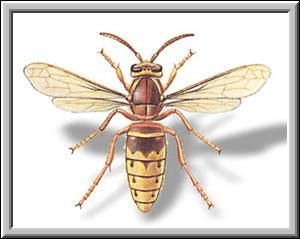Attacked by hornets:

Run over by a steamroller:

Moderator: Greg





hench wrote:how many hornet (pinata) stings does one have to receive in order to be dead-ified?
what is the steamroller's mph?



Rog wrote:hench wrote:how many hornet (pinata) stings does one have to receive in order to be dead-ified?
what is the steamroller's mph?
100-200 stings would probably do in someone who wasn't
allergic. Of course, one for those who are allergic.
The steamroller would be going about 1 mile per hour.
Rog wrote:hench wrote:how many hornet (pinata) stings does one have to receive in order to be dead-ified?
what is the steamroller's mph?
100-200 stings would probably do in someone who wasn't
allergic. Of course, one for those who are allergic.
The steamroller would be going about 1 mile per hour.
...The stinger of the Asian giant hornet is about a quarter-inch (6 mm) in length, and injects an especially potent venom that contains an enzyme so strong that it can dissolve human tissue. Masato Ono, an entomologist at Tamagawa University near Tokyo, described the sensation as feeling "like a hot nail through my leg."
...According to a report, one victim could not be recognized because said victim's face was dissolved beyond recognition due to numerous stings to that area.
...If a person is stung by the giant hornet and does not receive prompt medical treatment, he or she may die from a reaction to the venom. About 40 people die each year after being stung by giant hornets...
...Bees, other hornet species, and larger insects such as praying mantises are no match for the giant hornets, which often stalk their prey in relentless armies. Just one of these hornets can kill 40 European honeybees a minute; a handful of the creatures can slaughter 30,000 European honeybees within hours, leaving a trail of severed insect heads and limbs.
Heat Tolerance as a Weapon
The Japanese honeybee (Apis cerana japonica) has a unique way of defeating its sympatric predator, the giant hornet (Vespa mandarinia japonica). The Japanese honeybee is a small creature with a correspondingly small sting; as its primary means of defense cannot inflict much damage against such a large predator as the giant hornet, it requires another method of defense (Ono et al 1995). Instead of utilizing its stinger against the pack-hunting hornet, the honeybee instead waits for the predator, having earlier detected traces of its pheremonal hunting signals. As a hornet approaches the nest in an attempt to kill honeybees, a hundred or so will guard the nest entrance in an attempt to draw it on. When the hornet enters the nest, it is immediately mobbed by a clump of approximately 500 honeybees, which, surprisingly, do not sting the hornet to death as previously thought (Schmidt-Nielsen 2001). Instead, the bees heat themselves up to 47 degrees C very quickly using their flight muscles. As the hornet’s upper lethal temperature is 44-46 degrees C, it is killed quickly, effectively baked to death by the large clump of bees. The Japanese honeybee displays an amazing defensive adaptation, using its already extant endothermic qualities as an effective defense mechanism against their natural predator, the giant hornet (Ono et al 1995).
Return to “General Discussion”
Users browsing this forum: No registered users and 0 guests